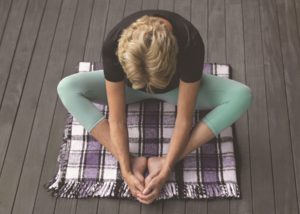Butterfly pose comes from a yoga tradition that is less well known than the one most people are familiar with. It grew out of the Taoist tradition, incorporating Chinese theories of how to cultivate the body’s energy, as opposed to the more active style of hatha yoga, which grew from the Hindu tradition.
A fundamental principle of Taoism is that all things are made up of yin and yang energies. Yang energy is active and hot. It is the sun; it makes things happen. The summer is a very yang time. Yin energy is passive and cool. It is the moon; it allows things to unfold. Yin energy is needed to balance the yang of summer.
The ancient Chinese philosophical texts attributed to Lao Tzu include this observation: “Nature is not in a hurry, yet everything is accomplished.” For me this is an inspiration to balance summer energy with an unhurried practice that is without striving. It is time for the Butterfly pose.

For Butterfly pose, sit on the floor with equal weight in both sitting bones. Bend your knees and place the soles of your feet together. Slide your feet forward (keeping the soles together as you do this); your legs will be folded in such a way as to make a big diamond shape.
The size of the diamond shape depends on what is comfortable for you. Focus on your hips and lower back as you settle into this position. You want some sensation in these areas, but not so much that you feel you can’t relax into it. You don’t want to feel any sharp pain or electric sensations.
Now place your hands on your ankles and lengthen your spine from the tailbone to the crown of your head. Slowly bend forward and down towards your feet. You may allow your head to gently release downward or you may keep it in a more upright position in line with your spine, depending on what is comfortable for your neck.
The distance between your head and your feet in this pose will depend on your flexibility. Listen to the sensations in your body. The object here is to find your edge — that is, the sweet spot where you naturally release into the pose. There is no need to force it.
In yin yoga, we assume the shape of the pose and then relax into it. This is a good time to breathe, relax, feel, watch, and allow.
If you need to give yourself more support to stay with this pose, please do. You can place a blanket under you for a softer place to sit. You can sit up on a cushion, which will take some stress out of the hips. You can support your knees by placing a folded blanket under them. Once you get settled with the support you need, let gravity keep you in the pose, using just enough muscular effort to maintain the shape and letting time do the work. Practice stillness.
You may find it easy to remain in this pose for three to five minutes or you may need to build up to that. These longer held poses allow the deeper tissues of the body to become revitalized. I am referring to the fascia, ligaments, tendons, and joint capsules. These tissues don’t stretch, but they can benefit from the gentle tug or pull that the pose creates.
Everyone has her own level of tolerance for staying in a position like this. If you are new to this type of practice, you may find you can hold the pose for only 30 seconds to a minute. Be gentle with your body.
I know in yoga many of us have some goal in mind. We want to look like a yogi in a magazine or like the person next to us in class, or we just want to follow the teacher’s instructions and hold the pose for three minutes because she says that’s what’s best. Let that go. Yoga is not a competitive sport.
I had a student once say to me that it was very hard for her not to push herself in yoga. She was aware of that feeling and told me, “It’s like I’m trying to win at yoga.” The real win in yoga is finding that just-right place in the pose for your body and appreciating it.
Yin yoga — and the Butterfly pose is just one example — can be a way to practice that, and an antidote to our busy summer lives.



